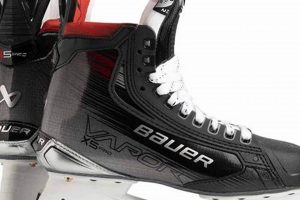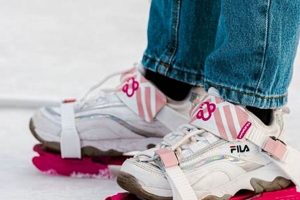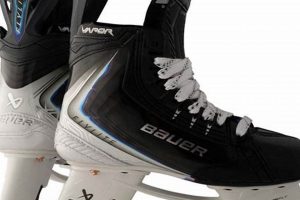The question of whether new ice skates are ready for immediate use upon purchase is a common one. Generally, skates do not come with a professional-quality sharpening. While some manufacturers might apply a basic edge, it’s primarily for protection during shipping and handling, not performance. This initial edge is often too dull or uneven for effective skating.
Optimal blade sharpness significantly impacts a skater’s performance and safety. Sharper blades provide better grip on the ice, enabling greater control, speed, and agility. Insufficiently sharpened blades can lead to instability, difficulty in turning, and an increased risk of falls. Historically, skate sharpening was a craft passed down through generations, with experienced professionals possessing the skill to create the precise edge required for different skating styles.
Therefore, understanding the necessity of professional sharpening is crucial. The subsequent discussion will delve into the reasons why new skates require sharpening, the types of skate sharpening available, and how to identify when skates need to be re-sharpened for optimal performance. Furthermore, factors influencing the longevity of a skate sharpening will be examined, along with advice on maintaining blade sharpness.
Skate Blade Preparation
Ensuring skate blades are properly prepared is fundamental for safety and performance. This section provides key considerations regarding blade condition and maintenance.
Tip 1: Understand the Initial Blade Condition: New ice skates, irrespective of manufacturer claims, require professional sharpening before use. The factory edge is often insufficient for effective skating.
Tip 2: Seek Professional Sharpening: Locate a reputable skate sharpening service familiar with the specific discipline of skating (e.g., hockey, figure skating). Discuss intended use to determine the appropriate radius of hollow (ROH).
Tip 3: Consider the Radius of Hollow (ROH): The ROH affects the blade’s grip on the ice. A smaller ROH provides more bite, suitable for sharp turns, while a larger ROH offers smoother gliding. Experiment to find the optimal ROH for individual skating style.
Tip 4: Inspect Blades Regularly: After each use, inspect the blades for nicks, burrs, or other damage. Minor imperfections can be addressed by a professional.
Tip 5: Dry Blades Thoroughly: Following each skating session, dry the blades completely with a soft cloth to prevent rust and corrosion. Moisture accelerates blade degradation.
Tip 6: Use Blade Guards: Always use blade guards when walking on surfaces other than ice. This protects the sharpened edges from damage caused by concrete, rubber, or other abrasive materials.
Tip 7: Store Skates Properly: When not in use, store skates in a dry, well-ventilated area. Remove blade guards to allow moisture to evaporate and prevent rust formation.
Properly prepared blades enhance skating performance and minimize the risk of injury. Regular maintenance and professional sharpening are essential investments.
The subsequent section addresses troubleshooting common skate blade issues and identifying when professional attention is needed.
1. Factory edge
The assertion “Factory edge: minimal” directly addresses whether new ice skates are ready for use upon purchase and relates to the core question: Do ice skates come sharpened? It acknowledges that any edge present on a new blade is insufficient for effective skating. This minimal edge is primarily intended to protect the blade during manufacturing, shipping, and handling rather than to provide a functional skating surface.
- Protection During Manufacturing
The “minimal” factory edge serves to prevent damage to the blade surface during the manufacturing process itself. The blade may undergo various treatments or processes that could scratch or mar the steel if it were fully sharpened and therefore more vulnerable. This protective edge is not crafted with skating performance in mind.
- Safeguarding During Shipping and Handling
The unsharpened or minimally sharpened state of the blade reduces the risk of injury to individuals handling the skates during shipping, stocking, and display. A razor-sharp blade poses a potential hazard in these environments. The “minimal” edge mitigates this risk, prioritizing safety over immediate usability.
- Prevention of Blade Damage
A sharp blade is more susceptible to damage from contact with hard surfaces. The “minimal” factory edge reduces the likelihood of the blade chipping, bending, or becoming dulled during transport and handling. This contributes to preserving the overall integrity of the blade until it is properly sharpened for use.
- Customer Customization
Manufacturers often leave the final sharpening to the customer, allowing for customization based on individual skating style, skill level, and discipline (e.g., hockey, figure skating). The “minimal” factory edge provides a blank canvas for a professional skate sharpener to create the precise edge profile required by the skater.
In summary, the “minimal” factory edge present on new ice skates is not a substitute for professional sharpening. It serves primarily as a protective measure during manufacturing and distribution, and allows for customer-specific customization of the blade’s edge. Therefore, a professional sharpening is an essential step before using new ice skates to ensure optimal performance and safety on the ice.
2. Professional sharpening
The statement “Professional sharpening: necessary” underscores a fundamental aspect related to the query of whether ice skates are ready to use upon purchase. Since new ice skates typically do not come with a performance-ready edge, professional sharpening becomes an indispensable step before their initial use. The absence of a properly sharpened blade directly impacts a skater’s ability to control movement, execute turns, and maintain balance. Consequently, the inherent state of new skates necessitates professional intervention to achieve functionality. A poorly sharpened or unsharpened blade introduces an increased risk of falls and injuries, hindering the skater’s progression and potentially causing dangerous situations on the ice.
Real-world examples highlight the significance of this understanding. A hockey player with unsharpened skates may experience difficulty stopping quickly, leading to collisions or missed scoring opportunities. A figure skater with dull blades will struggle to perform intricate jumps and spins, impacting their routine and overall performance. Recreational skaters, similarly, may find it challenging to simply maintain their balance, detracting from the enjoyment and safety of their experience. These instances illustrate the direct correlation between blade sharpness and skating efficacy, emphasizing the practical necessity of professional sharpening.
In conclusion, recognizing that “Professional sharpening: necessary” is a critical component of preparing new ice skates for use is paramount. Addressing this requirement ensures both safety and the ability to perform effectively on the ice. Ignoring this step represents a compromise in performance and an elevation in risk. The interconnectedness of “do ice skates come sharpened” and the need for professional preparation clarifies the need for skater awareness and proactive action prior to entering the rink.
3. Radius of Hollow
The radius of hollow (ROH) is a critical determinant of ice skate performance and directly relates to whether new ice skates are ready for immediate use. Since new skates typically lack a customized ROH, understanding its significance is paramount.
- Grip and Glide Balance
The ROH refers to the concavity ground into the skate blade’s bottom, creating two distinct edges. A smaller ROH yields a deeper hollow, providing increased grip on the ice, suitable for sharp turns and quick stops. Conversely, a larger ROH results in a shallower hollow, prioritizing glide and speed. The selection of an appropriate ROH is pivotal for optimizing performance, balancing the need for grip and glide based on the skating discipline and individual preferences. New skates lacking a customized ROH will not offer this essential balance.
- Skating Discipline Specificity
Different skating disciplines necessitate different ROH settings. Hockey players generally prefer a smaller ROH for enhanced agility and rapid acceleration. Figure skaters may opt for a slightly larger ROH to facilitate smoother gliding during jumps and spins. Recreational skaters may choose an intermediate ROH that provides a compromise between grip and glide. The standardized, often minimal, edge present on new skates does not account for these discipline-specific requirements, rendering them inadequate for specialized use.
- Impact on Skating Technique
An inappropriate ROH can significantly impede a skater’s technique. A hollow that is too deep can make it difficult to execute smooth glides, while a hollow that is too shallow can compromise edge control and stability during turns. This forces the skater to compensate, leading to inefficient movement patterns and increased fatigue. Since factory-finished blades lack a tailored ROH, they inherently compromise proper skating technique.
- Customization and Performance Optimization
Professional skate sharpeners possess the expertise and equipment to precisely grind the blade to a specific ROH. This customization allows skaters to optimize their performance based on their individual skating style, skill level, and the specific demands of their discipline. The absence of this customization in new skates necessitates professional sharpening to unlock their full potential and ensure a safe and enjoyable skating experience. It directly impacts the question of whether ice skates come ready to perform upon purchase.
Therefore, the radius of hollow is a key factor influencing skate performance and safety. Since new skates do not come with a customized ROH suited to the skater’s needs, professional sharpening is essential. This underscores the inadequacy of factory-finished skates and emphasizes the importance of seeking expert blade preparation before use.
4. Blade maintenance
The phrase “Blade maintenance: essential” highlights a critical aspect of ice skate ownership directly related to the question of whether new ice skates are ready for immediate use. While the initial sharpening addresses the blade’s profile, consistent maintenance ensures the longevity and performance of that sharpening.
- Post-Skate Drying: Preventing Corrosion
Moisture accelerates corrosion, which degrades the blade’s edge. Thoroughly drying blades after each use with a clean, absorbent cloth removes moisture and prevents rust formation. Neglecting this practice compromises the sharpness achieved through initial professional sharpening, ultimately diminishing performance and necessitating more frequent re-sharpening. The initial state of sharpness becomes irrelevant if not maintained.
- Blade Guards: Protecting the Edge
Walking on any surface other than ice dulls skate blades. Hard surfaces such as concrete and rubber are abrasive and can quickly damage the finely honed edge. Blade guards, typically made of plastic or rubber, provide a protective barrier, preventing contact with these surfaces. Consistent use of blade guards preserves the blade’s sharpness, maximizing the benefits of professional sharpening. Failing to use guards negates the value of a freshly sharpened blade.
- Regular Inspection: Identifying Damage
Periodic inspection of the blades reveals potential damage, such as nicks, burrs, or chips. Identifying these issues early allows for prompt corrective action, potentially preventing more significant blade damage and maintaining optimal performance. Ignoring visible imperfections leads to progressive degradation of the blade’s edge, requiring more extensive sharpening or even blade replacement. This proactive approach extends the period between professional sharpenings, preserving the initial investment.
- Professional Assessment: Determining Resharpening Needs
Even with meticulous care, skate blades inevitably lose their edge over time. A professional assessment determines when re-sharpening is necessary. Experienced sharpeners can evaluate the blade’s profile and identify subtle imperfections that may not be visible to the untrained eye. Waiting until the blades are excessively dull compromises safety and performance. Scheduled professional assessments ensure the blades are always in optimal condition, maintaining the investment made in initial sharpening.
In conclusion, while professional sharpening addresses the initial blade condition, consistent and diligent maintenance practices are essential for preserving the blade’s edge and extending its lifespan. Neglecting blade maintenance negates the benefits of professional sharpening, increasing the frequency of re-sharpening and potentially compromising safety and performance. The essential nature of maintenance, coupled with the common necessity of initial sharpening, underscores the importance of skater awareness and responsible skate care.
5. Initial condition
The statement “Initial condition: unready” directly addresses the question of whether new ice skates come sharpened and are ready for immediate use. It asserts that skates, as purchased, are generally unsuitable for effective or safe skating without further preparation. This unreadiness stems from the fact that, while some skates may possess a rudimentary edge from the manufacturing process, this edge is almost invariably inadequate for performance purposes.
The primary effect of this “unready” initial condition is that skaters attempting to use new, unsharpened skates will experience difficulty with control, balance, and maneuverability. For example, a hockey player might struggle to execute sharp turns or stop quickly, increasing the risk of collisions. A figure skater would encounter challenges in performing jumps and spins, while a recreational skater might simply find it difficult to maintain their balance. The “Initial condition: unready” is, therefore, a critical component in understanding the broader question of whether ice skates come sharpened; it underscores the need for professional sharpening to achieve functionality.
In summary, the “Initial condition: unready” highlights the essential prerequisite of professional skate sharpening. Recognizing this condition is vital for skater safety and performance. The understanding eliminates misconceptions regarding the out-of-box usability of skates. The subsequent adjustment of the blade ensures optimal performance.
Frequently Asked Questions
The following section addresses common inquiries regarding the condition of new ice skates upon purchase. The intent is to provide clarity on necessary preparations for safe and effective skating.
Question 1: Are ice skates sharpened at the factory?
New ice skates typically receive a basic, protective edge during manufacturing. This edge is not intended for skating and is insufficient for performance.
Question 2: Why is professional sharpening necessary for new skates?
Professional sharpening allows for customization of the blade’s radius of hollow (ROH), optimizing grip and glide according to skating style and discipline. Factory edges do not offer this customization.
Question 3: What happens if skates are used without sharpening?
Using skates with an unsharpened or inadequately sharpened blade can lead to instability, difficulty in turning and stopping, and an increased risk of falls and injuries.
Question 4: How often should ice skates be sharpened?
The frequency of sharpening depends on usage, skating surface, and skating style. Blades should be sharpened when they no longer provide adequate grip or exhibit signs of damage.
Question 5: Can sharpening be performed at home?
Professional sharpening requires specialized equipment and expertise. Attempting to sharpen skates at home without the proper tools and knowledge can damage the blades.
Question 6: What is the Radius of Hollow (ROH)?
The ROH refers to the concavity ground into the skate blade’s bottom, creating two distinct edges. It influences the blade’s grip and glide characteristics on the ice, requiring careful consideration for optimal performance.
In summary, new ice skates generally require professional sharpening before their initial use to ensure safety and optimize performance. Recognizing this necessity allows for proper preparation and enhances the skating experience.
The subsequent discussion will delve into the specifics of skate sharpening techniques and maintenance procedures.
Conclusion
The preceding discussion has established that the question, “do ice skates come sharpened,” warrants a definitive answer: generally, no. While a rudimentary edge may exist, it is insufficient for safe and effective skating. Professional sharpening is a necessary prerequisite to optimize performance, enhance control, and minimize the risk of injury. The specific radius of hollow, tailored to individual skating styles and disciplines, cannot be replicated by factory-applied edges.
Therefore, prospective skaters must recognize the essential nature of professional skate sharpening. Neglecting this crucial step compromises safety and performance. Ongoing maintenance, including diligent drying and protective measures, is also necessary to preserve the sharpened edge. A proactive approach to skate preparation ensures a safe and enjoyable skating experience, maximizing the skaters potential on the ice.







